Architecture at the Edge: Designing for Wildlife at the Waterfront
Using bio-positive design to create opportunities that support flora and fauna at the ocean's edge also create resilient and educational waterfront sites.
View Post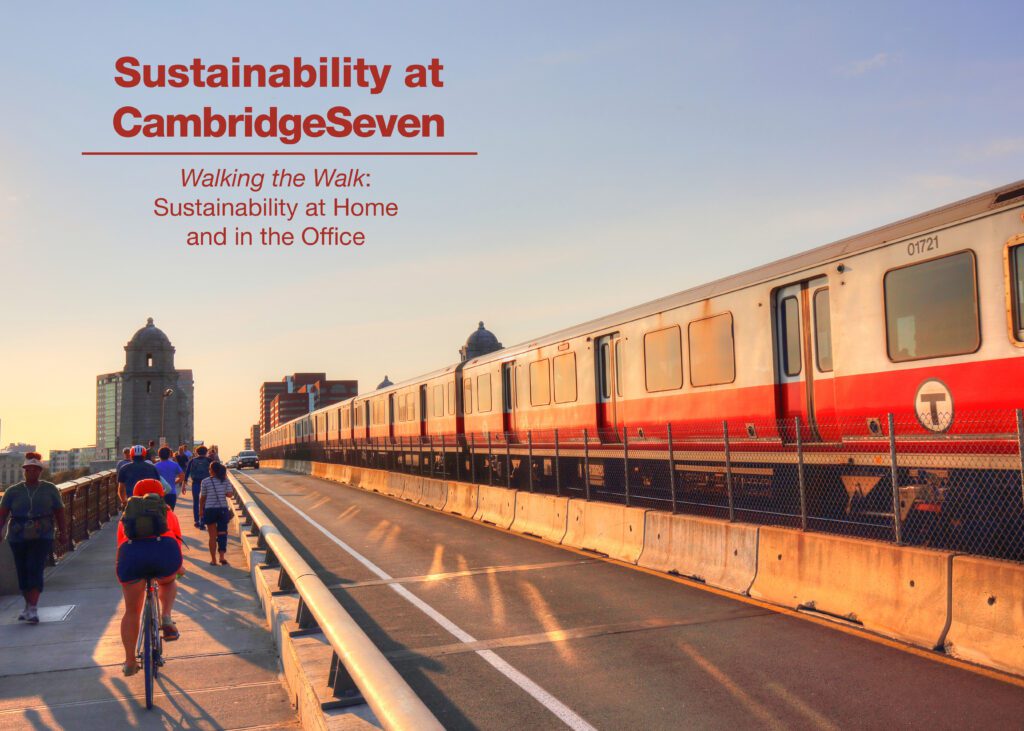 At CambridgeSeven, we work diligently to create and design sustainable architecture, and we are constantly educating ourselves and others on advances in materials and best practices. Our in-house team, including LEED, Passive House and Living Future Professional-accredited architects collaborates with engineers and other consultants to create total building system integration for our diverse range of clients, including higher education, aquariums, museums, civic and hospitality.
At CambridgeSeven, we work diligently to create and design sustainable architecture, and we are constantly educating ourselves and others on advances in materials and best practices. Our in-house team, including LEED, Passive House and Living Future Professional-accredited architects collaborates with engineers and other consultants to create total building system integration for our diverse range of clients, including higher education, aquariums, museums, civic and hospitality.
With a staff so passionate about sustainability, it’s no surprise that many team members have embraced and implemented these principles beyond the office.
Renewable energy is increasingly affordable and accessible to homeowners, with cities and towns helping citizens convert from fossil-fuel-powered homes to fully electric. Several from CambridgeSeven have embraced PV and Senior Associate Bert Bremer, AIA, is a local pioneer and celebrated example of embracing solar energy.
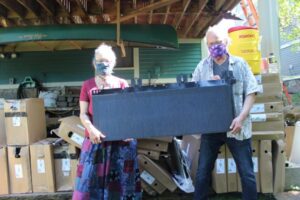
Bert was the first Massachusetts homeowner to install an entire roof of low-profile, tile-like Tesla V3 solar panels.
“Our roof peak runs directly north to south, so for a long time we thought solar wasn’t going to work out for us,” he said. The power density of the panels allows Bert’s roof to maximize the sunlight it does get to create more than enough energy.
Installed in 2020, the roof has been fully functional for nearly three years and uses the energy it creates to operate Bert’s 2,200 SF home, with the excess energy recharging and returning to the Powerwall battery system, which operate the house with backup energy when sunlight is limited. Once the batteries are fully charged, the roof sends the excess back into the grid and Bert is reimbursed by the state for returning this surplus energy. He tracks the exact energy rates on Tesla’s mobile app and anticipates breaking even on his investment a little more than 10 years after installation.
“It helps to save money, definitely,” Bert said. “But for us it’s about trying to live lightly on the planet and doing what we can to reduce our carbon footprint.”
To that end, Bert, a long-time bike commuter, also reports that he’s replaced all gas-powered lawn and garden equipment with electric tools (powered by his roof, of courses) and has an induction cooktop and new heating system in his future, completing his move to a fossil-fuel-free home.
In another approach to running a home on renewable energy, Associate Madeline Burns, AIA, LEED AP BD+C, CPHC, had the opportunity to implement renewable energy measures when she completed a recent gut renovation of her 3-unit (or triple-decker as they’re locally known) home.
“I set up our house to be 100% on renewable power from the grid,” Maddie said. This is an opt-in choice in her city of Somerville, and is offered in many other Boston neighborhoods, too. “I also converted our house to all electric heating and cooling with mini splits.”
Maddie, an action-oriented sustainability advocate, worked with Mass Save, a collaborative of Massachusetts utility service providers aiding in and encouraging communities to make energy-efficient upgrades, to insulate her multi-family home. Mass Save helps finance certain home upgrades, including Maddie’s insulation and mini split additions. “This was while I was doing my Passive House Institute U.S. certification…[so] I was very involved in the air sealing,” she said.
Many in our office, when in need of an upgrade, choose to replace older gas appliances with electric, eco-conscious versions to help keep move their homes in a sustainable direction.
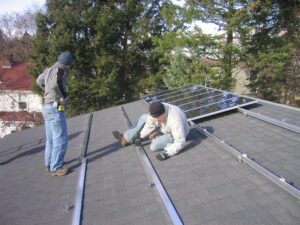
Associate Principal David Wiborg, AIA, used the opportunity of a small addition to integrate renewable energy throughout his home. “Our new addition includes clerestory and tubular skylights for natural lighting,” he said. “We also included a 24-PV array for solar power,” which David reports has harvested a total of 57,230 kilowatt hours since he installed it in 2003. “It was well worth it,” he said. David paid around seven thousand dollars out of pocket for the array and, based on Massachusetts’ current kWh rate of $0.21, he has saved a total of nearly eleven thousand dollars, meaning he has now surpassed breaking even on the cost of installation.
The house of Senior Associate Sharon Clarke, AIA, has a net-positive solar array, and a unique aspect of her home allows her to have better energy efficiency: a continuous perimeter of deep roof overhangs that were part of the house’s original 1948 design plans.
“In the summer, these overhangs block nearly all direct sunlight from entering the interior during the hottest times of day,” she said. “At night, we open windows letting the house fill with cool air, then close them all again in the morning, creating a cool indoor temperature all day long without the use of air conditioning.”
The solar array, installed in 2017 by the house’s previous owners, helped tip the scales when deciding to purchase. “It was definitely part of the reason we bought this house,” Sharon said. Since its installation, the array has generated 63.9 MWh, with an average yearly production of 9.36 MWh. It has saved 100,0067 lbs. of CO2, which is equivalent to planting 756 trees.
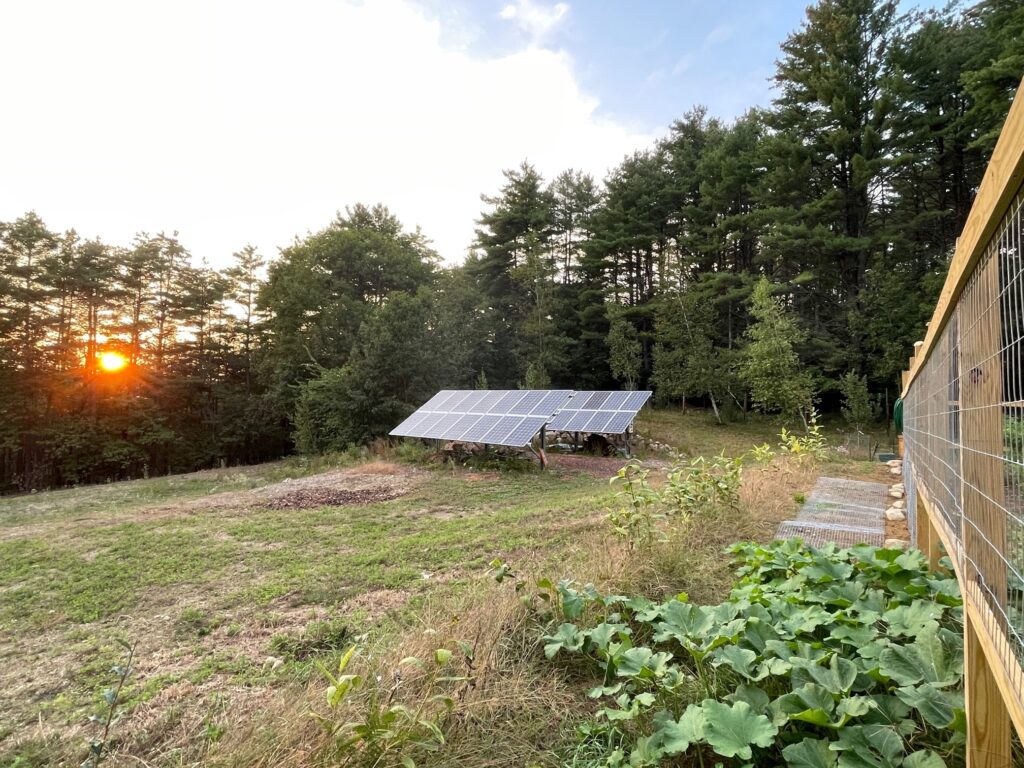
When renovating his older home, Associate Jacob Bloom, LFA, paid extra attention to the quality of replacement materials and appliances.
“We insulated and upgraded the efficiency of our heating system,” he said. “I have an induction stove and low-flow plumbing fixtures.”
In addition to renewable energy, CambridgeSeven staff “walks the walk” in terms of sustainable and healthier building materials, such as Associate Principal Doug Simpson, LEED AP BD+C.
“We re-sided our house with cement board clapboard which holds paint pretty much permanently, unlike wood clapboard which requires regular repainting,” he said. The cement clapboard is durable compared to wood, which helps to cut down on paint usage.
Speaking of paint, Senior Associate Douglas Flandro, LEED AP, BD+C, ID+C, CPHC, author of the “Sustainable Exhibition Design and Construction Toolkit” on Mindful Materials, is one of our in-house experts on paints, adhesives, textiles and other indoor materials that have lower-impact alternatives. Douglas F. reports using low- or zero-VOC paints and water-based varnishes in his home to improve healthy air quality for his family, some of whom have asthma. “We have an air quality monitor which tells us when to open our newly installed triple-pane windows to let in some fresh air,” he said.
Principal Chris Muskopf, AIA, quite literally took his knowledge from work home with him. “For the [LEED Platinum] Roux Center for the Environment, we installed a regional poplar cladding with a sustainable heat-treated preservation technique,” Chris said. “I liked it so much that I decided to build my backyard fence out of the material and worked with the same suppliers to get it.” The regional material is suited to our climate, weathers appropriately and minimized extensive shipping-related energy use.
“We’ve also salvaged all our 1890’s original floors for use in new woodworking projects in the home shop,” he said. “The lessons learned on office projects provide a great benefit to DIY home improvement efforts.”
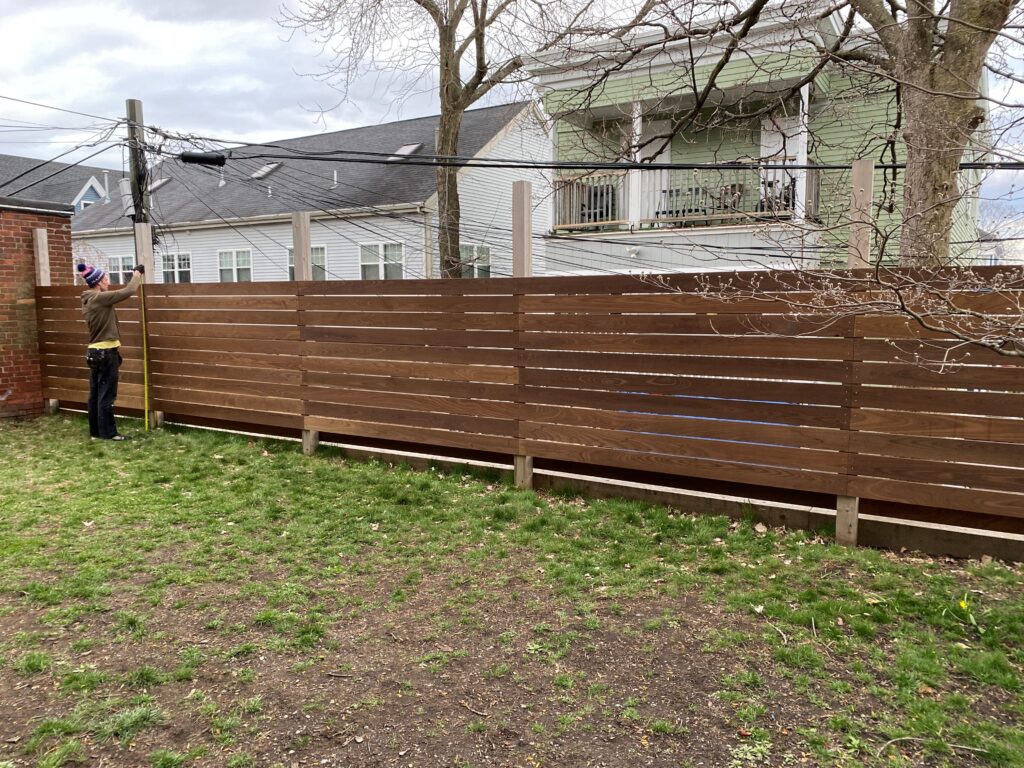
In the office, Maddie, Douglas F. and Jacob advocated for the new Mass. Stretch Code, which emphasizes energy performance. “Our office was involved [with changing] the energy code to be the most aggressive energy code in the nation,” Douglas F. said about their efforts. “That is change on a huge scale that is worth celebrating.”
“Doing something like that probably amounts to 50 million times more of an impact than me biking to work daily,” Maddie said.
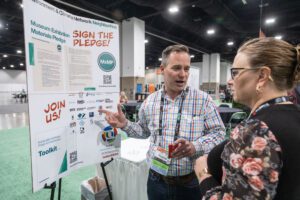
Though very sustainability-minded in her own life, Maddie believes there should be less pressure on single consumers, and more responsibility on large-scale economics and governing parties. “The biggest thing I do is support government policies and candidates who actively work towards climate responsibility,” Maddie said.
While nearly 98% of CambridgeSeven recycles at home, many share a concern regarding confusion around home recycling and reducing our overall footprints. Many work diligently to reduce reliance on single-use plastics at home because, as Douglas F. notes: “most of the plastics we put in the recycling bin are not recycled. This is due to the [industry making us] think we are doing something about the environment to deflect from what [larger entities] need to be doing.”
Close to a quarter of our staff commute by bike, including several who ride in even the worst of weather conditions. We also have many who regularly take public transit, resulting in a significant number who actively choose not to drive. Maddie has just about ruled out all car usage; by biking and walking around Boston and its outer neighborhoods, she has eliminated her need for one.
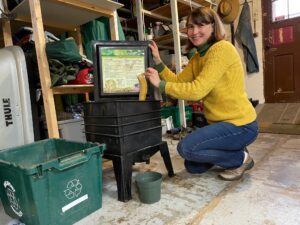
Douglas F. chose to buy a house close enough to work so that would be possible, and over 35% of others rely on bikes, walking or running, or public transit to get to our office, jobsite meetings in Boston and Cambridge, and many even use their bikes to ferry children to school and activities and to run weekend errands.
Noting that fashion is one of the largest contributors to landfills each year,
Jacob, is one of many in the office focused on the source of their clothing. “I try to buy sustainably and equitably produced clothing,” said Jacob. Others, like Doug S., actively focus on purchasing clothes second-hand, and as well as reusing or donating older items.
Doug S. notes that his current goal is to rid the house of PFAS but recognizes its challenges: “They can be found in everything, from non-stick pans to even dental floss,” he said.
Gardening, composting, including an active vermiculture project, and rainwater collection are all very common at CambridgeSeven, both in homes and in the office, where our robust rooftop herb and vegetable garden is literally a breath of fresh air above the city streets.
We’ve cut down on plastic usage by eliminating single-use plastics such as straws, cutlery and cups, as well as investing in reusable glassware and utensils for staff use. CambridgeSeven no longer buys bottled water, all water comes from the refrigerator water dispenser or tap, and instead, we serve drinking water to guests in our washable glass bottles, which are etched with our logo. We push for eco-friendly travel to and from the office, including bicycle commuting reimbursement. In addition to general paper, plastic and metal recycling, we recycle office architectural samples and office equipment by returning them to vendors, donating them to community organizations such as the Boston Building Resources Reuse Center, or by using the Re-Stream purge bin recycling service. We recycle our office and personal techno-junk annually through Earthworm Recycling.
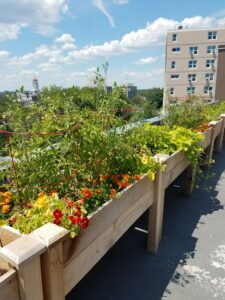
Our office garden, which rests on our building’s rooftop is run by Office Manager Millie de Olio, who uses the fresh herbs, veggies and other produce to bake sweet and savory treats for the staff.
As a sustainably focused practice, CambridgeSeven works hard to create and design sustainable architecture. We are signatories to the AIA 2030 Commitment, and our staff, individually and collectively, continues to lead the way.
Using bio-positive design to create opportunities that support flora and fauna at the ocean's edge also create resilient and educational waterfront sites.
View PostHow aquariums are making their conservation and sustainability actions the theme of exhibits and vital components of their architecture.
View Post